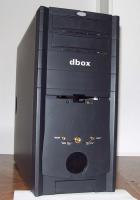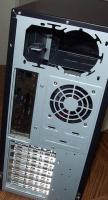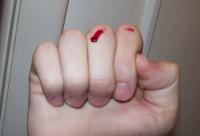Ahanix dBox: Standardizing LCD Case Controls
by Kristopher Kubicki on January 9, 2003 5:44 AM EST- Posted in
- Cases/Cooling/PSUs
Construction
Since the selling point of the dBox was its LCD control, we were unsure about how the rest of the case would perform. It has been a while since we have reviewed a non-aluminum case, so it was a little nostalgic to the see the familiar plastic and steel construction on the dBox. Our dBox came in a dull black finish, with a black plastic faceplate.
Breakdown
|
This case came with one 120mm intake fan and one 80mm exhaust fan. Fortunately, the 120mm fan is not incredibly loud, as we will see in our noise test of the case. As we have seen on most new cases, the intake fan had a small dust filter. However, judging from the picture below, it appears to have somewhat of an unusual fit. At first we were a little confused as to why this case came with at 120mm fan, but after looking at the overall layout of the case, the reasoning seems obvious.
Since the dBox has an LCD panel in the front, there are no holes directly in front of the fan for intake. Air from outside the case must be pulled in from cracks in the case front. Apparently, a 120mm is necessary to generate enough intake to sufficiently cool the components. An odd design, but even stranger still, the dust filter seemed to be a little too large for the opening it covered, thus its unusual fit.
Unlike many of the cases we have seen on the market lately, the dBox had no removable drive bays. This is particularly disappointing because the bays are oriented in a fashion that really makes it difficult to install drives when a full array of PCI and AGP cards are installed.
Something we have not really seen on many cases before the Ahanix was the low PSU obstruction. Most typical cases have a bar that runs along the PSU which it can sit on. Unfortunately, that same bar can provide a real hassle when removing or adding hardware. Ahanix solved this problem by simply folding down a piece of the same wall that the motherboard rests on. Thus, the inner corner of the power supply rests on a solid surface, while the outer corner hangs suspended. If the four screws in the back of the PSU are tight, the suspension should not be a problem.
As we have stressed enormously in our other reviews, sharp edges really degrade the overall quality of a case. Unfortunately, like the Lian Li case we reviewed last month, there were several sharp edges on the dBox. Most were in fairly secluded areas of the case, but several sharp edges still persisted, especially on the left panel. A computer hardware related injury seemed unavoidable.














0 Comments
View All Comments